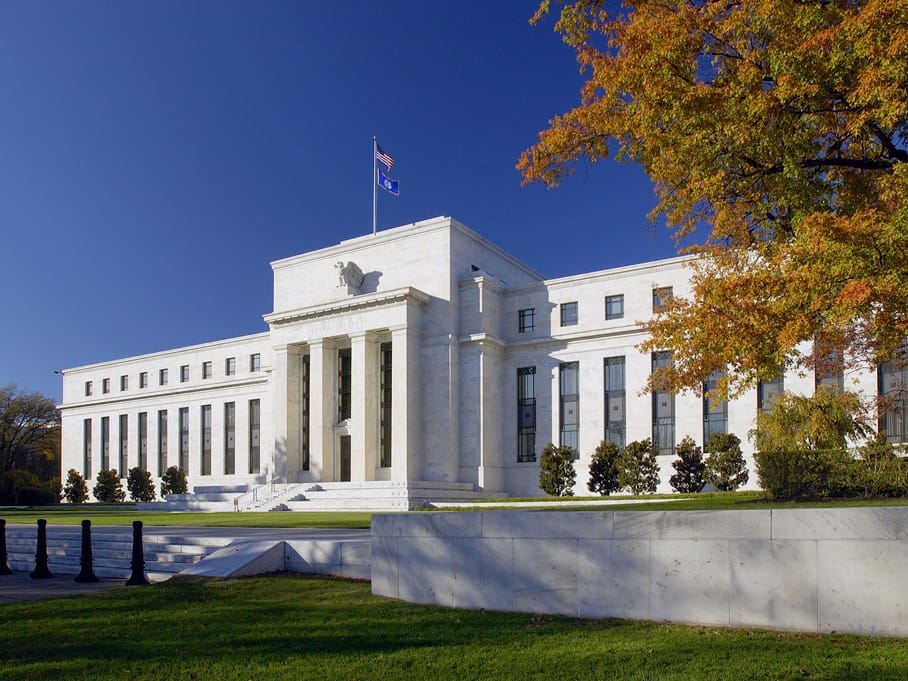Stronger-than-expected US GDP data released earlier today and the Federal Reserve’s latest interest rate hold announced this evening, are fuelling a fresh round of speculation over inflation, tariffs, and Trump-era politics. Market strategists warn that despite signs of resilience, rate cuts remain elusive, with implications for global markets and adviser portfolios.
With US GDP jumping to an annualised 3.0% in Q2, beating consensus expectations and marking a sharp rebound from the previous quarter, hopes of a near-term interest rate cut have once again been dashed. Hours after the data release, the Federal Reserve confirmed it would hold the federal funds rate at 4.25–4.5%, in line with most market expectations, citing a still-uncertain outlook and persistent inflation pressures.
For UK financial advisers, the economic signals from across the Atlantic are becoming increasingly important. The US economy’s trajectory continues to drive sentiment across global markets, influence bond yields, and affect asset allocation decisions, especially in the face of growing political tension between President Trump and Fed Chair Jerome Powell.
IFA Magazine has gathered expert views from leading investment strategists to assess what these data means for policy, the US economy and the path ahead for global investment portfolios as follows:
Commenting on the US growth data announced this afternoon, Nathaniel Casey, investment strategist at wealth management firm Evelyn Partners, comments:
“The US economy expanded above economists’ expectations in the second quarter and was stronger than in Q1 (when the economy contracted), with real GDP growing at 3.0% on an annualised basis in Q2. This figure was higher than the 2.4% expected by the consensus of economist’s forecasts and came in just above the final estimate from the Atlanta Fed GDP nowcast which estimated GDP at 2.9%.
“Given the solid growth data, steadily rebounding consumption and early signs that tariffs are beginning to feed into June’s inflation figures, the Federal Reserve will be even less inclined to cut rates either this week or in the coming months. This is likely to pile on the tensions between President Trump and Fed Chair Jerome Powell, who has played the President’s calls to lower interest rates with a straight bat. With just hours to go till the output of the July FOMC meeting, markets are currently expecting no change from the committee with near full conviction.
“This growth was driven primarily by a sharp rebound in net trade. The external sector contributed a substantial 5.0 percentage points to the headline figure, the strongest contribution from trade since early 2020. This was driven by a sharp fall in imports, a reversal of the surge in imports we saw in the Q1 data, when there was peak uncertainty around tariffs.
“Despite the strong headline number, domestic demand remained subdued. Personal consumption contributed just 1.0 percentage point to growth, while this was marginally stronger than Q1 helped by an improvement in consumer confidence, it remains below the levels seen throughout 2024.
“Having been the largest positive contributor last quarter, with firms rushing to replenish inventories before tariffs were implemented, inventories became a major drag in Q2, subtracting 3.2 percentage points from GDP — the largest negative contribution from this category since Covid. This suggests that firms drew down heavily on stockpiles, with uncertainty around import costs and consumption being a likely driver.
“Fixed investment and government expenditure both made marginal contributions of 0.1 percentage points each, reflecting a steady but unspectacular pace of capital spending and public outlays. Overall, this report largely reflects a reversal of Q1, with falling imports and depleting inventories in Q2.
“Following this data release, US Treasury yields rose, and the dollar strengthened, meanwhile US equities were largely unchanged heading into market open.”
Commenting on this evening’s Fed interest rate decision, Richard Carter, head of fixed interest research at Quilter Cheviot said:
“Even after his visit to check in on the Federal Reserve’s renovation, Donald Trump continues to be defied in his quest to get interest rates cut. The Fed has held rates at 4.25%-4.5% and show no sign of cutting for now. Tariffs continue to leave an uncertain picture for the US economy and with Friday’s deadline for any final ‘trade deals’ looming, what the end trading relationship looks like between the US and the rest of the world is unclear.
“Ultimately, the data coming out of the US continues to vindicate the Fed’s position. Although somewhat distorted, GDP for Q2 came in at a better than expected 3%, while inflation is on an overall downward trajectory. The US jobs market, too, continues to hold up in the face of pressures instigated from Donald Trump’s tariff announcements. The problem for Trump is that he wants both a strong economy and low interest rates, but right now it looks like he can’t have both.
“Eyes will now turn to September’s meeting given the slightly more dovish tones emanating from the Federal Reserve in the past month or so. Jerome Powell will not want to be seen to be appeasing Donald Trump and will want the Fed to maintain its independence. It is a difficult position for the Fed to be in and as such retreating into wait and see mode will be the favourable approach. But if inflation continues to remain under control and cracks begin to appear in the labour market, the Fed will need to be prepared to act quickly, yet continue to block out the noise from Donald Trump.”
Garry White, Chief Investment Commentator at Charles Stanley, also comments on the Fed’s decision to hold saying: “The Federal Reserve (Fed) remains cautious about declaring victory over the recent prolonged surge in inflation, as the American economy continues to show significant resilience. The US economy grew at an above-consensus annualised rate of 3% in the second quarter, rebounding from a contraction in the first three months of 2025, during which Donald Trump’s tariffs triggered a huge swing in imports, which are a detractor from gross domestic product (GDP). The Trump tariffs do not appear to have resulted in a significant impact, but they may reignite price pressures later this year. A cut in interest rates at this stage would have been unwise, given the persistent nature of inflation following the post-Covid spike. The Fed’s wait-and-see policy looks correct.”
Sharing his analysis on the FOMC decision, Richard Clarida, PIMCO Global Economic Advisor said:
“The Federal Reserve kept interest rates unchanged at a level that Chairman Jerome Powell characterized as “moderately restrictive” and two Fed Board governors dissented to argue in favor a rate cut. During the press conference, however, Powell declined to provide any guidance on the outlook for interest rates, instead sticking to data dependence and downplaying the signal from the June SEP which showed the median Fed official looking for 50 bps of rate cuts in 2025.
“Chair Powell’s data dependent approach came across as somewhat hawkish relative to consensus expectations hoping that Powell might provide a hint of a potential rate cut at the upcoming September FOMC meeting. This resulted in markets pricing in modestly lower odds of a rate cut in September.
“The Fed remains data dependent and will have two months’ of inflation and employment data before policymakers meet again in September. Our base case remains that the Fed will begin cutting rates in the second half of this year as we expect the economy to continue to slow; however, uncertainty remains high and data will continue to drive the Fed, and subsequently, the market’s view on where to take interest rates next.”
Also commenting on today’s FOMC decision, Max Stainton, Senior Global Macro Strategist at Fidelity International, said:
“As expected, the Federal Reserve (Fed) kept the Fed funds rate unchanged at 4.25-4.5%. Additionally, the statement saw limited amendments, with the main change being a downgrade in the assessment of current economic growth. However, the duel dovish dissents by Governor Waller and Governor Bowman calling for a rate cut at this meeting was much more significant. The dissent from Governor Waller was not entirely surprising given his most recent speech, titled “The case for cutting now.” And while Governor Bowman’s dissent was slightly more surprising, it is consistent with her very dovish remarks in June. While this is the first time since December 1993 that two Governors have dissented, we don’t believe these dissents convey much signal onto the debate in the committee. It is well known that both individuals are currently auditioning for the Fed Chair appointment, and as such have to burnish their dovish credentials.
“At the press conference, while Chair Powell was deliberate in his efforts to emphasise data dependence, reasonably highlighting that two employment reports and two inflation reports are due between now and the September meeting, he also pushed back at the idea that a September cut was imminent, stating that current financial conditions are fairly easy. This quiet hawkishness from Powell sets up a continuing political battle between the Fed and the executive, and is indicative of the broader political pressure that Powell and the Committee will come under as a result of this pause – particularly after the Waller/Bowman dissents. To emphasise this point, the President wrote on social media immediately after the release of the statement that he expects rates to be cut in September.
“Looking ahead, we continue to expect the US economy to pass through a stagflationary phase through the rest of the year, as a result of effective tariff rates moving up to the 18-20% range, with inflation likely to reach 3.5% by Q4, and underlying growth remaining subdued at below 1%. However, risks are also building that the growth shock from tariffs will be larger than expected with a resultant larger negative shock to the US labour market. Given this outlook, we expect the Fed to break into three distinct camps as the year progresses. The first camp will consist of ‘political cutters’, who are advocating for cuts as much to get the attention from the President as anything else. The second, a classically dovish camp that puts more weight on the weakening labour market fundamentals. Finally, a third hawkish camp that stick rigidly to the Fed’s mandate in weighting inflation and unemployment equally, cautious of stagflationary pressures persisting for the rest of the year and into next, that have a preference for keeping the Fed funds rate high for longer.
“In this press conference it was clear that Powell firmly sits in this latter camp, and as a result we continue to expect cuts to only start in December this year, a view we’ve held since November 2024.”
Sharing his reaction to the data and analysis of its impacts, Robert Lind, Economist at Capital Group said:“The full impact of recent trade agreements has yet to materialise, leaving policymakers to navigate a delicate balance between slowing growth and the risk of persistent inflation. While the Federal Reserve has adopted a neutral stance for now, we are relatively constructive on the outlook for global growth.
“That said, we’re beginning to see early signs of softness in the US economy. The impact of tariffs is likely to push inflation higher while slowing growth, which will put more pressure on the Fed. A modest policy easing later this year appears plausible, but the Fed’s flexibility could be limited if inflation proves more stubborn than expected.
“In Europe, central banks are also expected to ease policy slightly to offset the effects of tariffs and currency strength against the dollar. Meanwhile, Japan is likely to continue its gradual tightening path. Overall, the global policy environment remains mixed, and investors should stay alert to how central banks balance inflation risks with the need to support growth.”
Commenting on the Fed’s decision, Lauren Hyslop, Fund Manager at Mattioli Woods, said: “With markets having fully discounted this outcome, the decision is unlikely to trigger significant asset price movements. Chair Powell has articulated the Fed’s deliberate patience, adopting a watchful stance as policymakers weigh competing economic forces and assess which tariff-related risks warrant greater concern. Having reduced its benchmark rate by a full percentage point late last year as pandemic-era inflation pressures subsided, the central bank has since remained on pause.
“Market participants find themselves in a holding pattern, broadly expecting the Fed to maintain its current stance through the summer months whilst increasingly positioning for a 25 basis point reduction come September. Attention now turns to the Fed’s communication nuances, potential dissenting voices, and the evolving economic narrative leading up to the next gathering.
“Meanwhile, US equities have scaled successive peaks in recent weeks, rebounding sharply from April’s depths. This impressive rally reflects enduring confidence in America’s economic resilience, despite ongoing trade tensions, and mounting enthusiasm for artificial intelligence’s transformative potential across the nation’s corporate giants. Yet the Fed faces a delicate balancing act: premature easing amidst robust growth and buoyant markets could inadvertently stoke demand, risk rekindling inflationary pressures, and foster asset price excesses; ultimately necessitating more aggressive policy correction down the line.”















